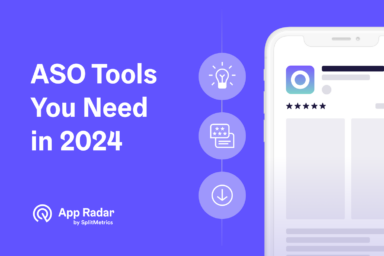What is App Cannibalization in App Stores?

In this article, we’ll explore the concept of app cannibalization, how to measure its impact and strategies to identify and mitigate it.
Paid User Acquisition and App Store Optimization Relationship
Paid user acquisition (UA) and app store optimization (ASO) are closely connected and can significantly influence each other. The traffic generated through paid UA campaigns can enhance organic search rankings and the visibility of an app’s creative assets in the app store.
This is because a higher volume of downloads, even if driven by paid ads, signals to app store algorithms that the app is popular and relevant, potentially leading to improved organic visibility.
However, this relationship can be a double-edged sword.
If an app already has a good organic ranking, running an ad for the same keyword might not lead to additional downloads. Users who found the app organically might click on the ad instead, wasting ad spend.
Why Do App Store Optimization Experts Need to Pay Attention to App Cannibalization?
App Store Optimization (ASO) experts need to pay attention to app cannibalization because it can negatively impact the effectiveness and efficiency of their marketing efforts.
ASO experts need to be aware of cannibalization to:
- Optimize Ad Spend – understanding the extend of app cannibalization helps ASO experts make informed decisions about keyword bidding and budget allocation in Apple Ads campaigns. They can identify keywords where cannibalization is high and adjust their bidding strategies accordingly to avoid overspending on users who would have downloaded the app organically.
- Maximize Organic Growth – ASO focuses on improving an app’s visibility and conversion rate through organic or app search channel. App cannibalization can undermine these efforts by reducing organic downloads. Understanding cannibalization ensures that ASO optimization strategies drive the maximum possible organic growth.
- Improve Return on Investment (ROI) – cannibalization directly affects the ROI of ASA campaigns. When paid installs replace organic installs, the cost per acquisition (CPA) increases, and the overall return on investment decreases.
Simply said – if you can minimize cannibalization, you can improve the ROI of your marketing campaigns.
Organic Uplift vs. Cannibalization
Organic uplift is the increase in organic visibility, conversion rates, and keyword rankings that can result from running Apple Search Ads (ASA) campaigns.
The increased downloads generated by ASA can signal to the App Store algorithm that the app is popular and relevant. This leads to improved organic visibility in search results and potentially higher rankings for relevant keywords.
This can create a positive feedback loop, where the increased organic visibility leads to even more organic downloads. However, this organic uplift can be accompanied by cannibalization.
App marketers and developers need to strike a balance between organic uplift and cannibalization.
While running ASA can be a valuable tactic for boosting app visibility and downloads, monitoring and analyzing the data is key to ensuring that paid campaigns do not replace organic traffic.
What’s an App Cannibalization Example?
There are many app cannibalization examples in App Store, but a good example of app cannibalization is Twitter’s use of Apple Search Ads.
Twitter was running a brand campaign, which resulted in users seeing two snippets from the same app at the top of the search results without needing to scroll.
Given that Twitter’s app would likely appear as the first organic result anyway, the ad may not be driving any additional downloads. Instead, it replaced organic downloads with paid ones, leading to unnecessary expenses.
This example highlights the importance of carefully balancing paid user acquisition efforts with organic search optimization to avoid redundant spending and maximize efficiency.
What is Brand Keyword Cannibalization?
Brand keyword cannibalization occurs when a company’s paid ads compete with their organic search results for their own branded keywords.
This happens when a user searches for a brand, and the ad appears at the top of the search results.
As a result, the user clicks on the ad instead of the organic listing. As with Twitter’s example discussed previously, the company pays for the added spend.
Brand keyword cannibalization is common, especially for well-established brands with high organic rankings who want to defend their brand.
Here are the best approaches for managing brand keyword cannibalization:
- Pause Brand Defense Campaigns. Temporarily stop brand defense campaigns to measure the extent of cannibalization. This can help determine if the paid ads are indeed replacing organic traffic.
- Optimize Ad Spend. Adjust bidding strategies and budget allocation to focus on keywords with lower cannibalization risk. This ensures that paid campaigns complement organic efforts rather than compete with them.
- Monitor and Analyze Data. Regularly review performance data to identify instances of cannibalization. Use this data to refine keyword strategies and improve the overall efficiency of marketing efforts.
While Apple Search Ads (ASA) effectively protect a brand’s keywords from competitors, they can also lead to cannibalization. This creates a dilemma: Should developers bid on their own branded keywords to safeguard them from competitors, even if it adds more costs for installs that might have been free?
To answer this question, developers can use a method to measure the cost of cannibalization versus brand protection.
How to identify app cannibalization?
Identifying cannibalization can be challenging due to Apple’s lack of granular organic keyword data. However, ASO experts should analyze the available data and conduct controlled experiments to gain valuable insights.
Here is a list of indicator methods to help you detect cannibalization
Drop in Organic Downloads
Despite stable overall traffic, a noticeable decrease in organic downloads could signal cannibalization. This suggests that paid downloads replace organic downloads that would have occurred naturally.
Simultaneous Increase in Paid Downloads
If paid downloads increase while organic downloads decrease, it strongly indicates cannibalization. This implies that users who would have found the app organically clicked on the paid ads instead.
Analyze Specific Campaigns/Keywords
Examine the performance of individual campaigns and keywords in ASA to identify which ones contribute the most to cannibalization. If pausing a particular campaign or keyword leads to an increase in organic downloads, it suggests that the campaign or keyword was cannibalizing organic traffic.
Use App Store Connect
Although Apple does not provide organic keyword-level data, you can use App Store Connect to monitor changes in organic downloads and compare them with paid downloads from ASA. If you observe a decline in organic downloads after starting ASA campaigns, it could be a sign of cannibalization.
How to Measure App Cannibalization Costs?
Cannibalization costs are measured using a structured approach of comparing the financial impact of paid ads replacing organic installs.
Here’s a mentioned method to calculate these costs:
STEP 1: Define Cannibalized Installs
Cannibalized installs are the total number of installs generated from ASA campaigns minus the protected installs. These are the installs that would have occurred organically without the ad intervention.
STEP 2: Calculate Protected Installs
Protected installs are the estimated number of installs that would have happened organically without the ad. This is calculated by multiplying the ad impressions with the estimated competitor conversion rate.
Protected Installs = Impressions * Estimated Competitor Conversion Rate
STEP 3: Determine Cost Per Protected Install
This metric is calculated by dividing the total ad spend by the number of protected installs. It helps understand the cost efficiency of ad spending in protecting organic installations.
Cost Per Protected Install = Total Ad Spend / (Impressions * Estimated Competitor Conversion Rate)
STEP 4: Compare Costs
Compare the cost per protected install with the cost per install reported by ASA. This comparison helps estimate the “protection premium” paid for a campaign and the proportion of ad spending on cannibalization.
Keep in mind – this method simplifies reality and doesn’t account for all factors, such as users who ignore ads or don’t download after searching. The method’s accuracy depends on the precision of the estimated competitor conversion rates.
Key Takeaways on App Cannibalization
App cannibalization occurs when an app’s paid ads compete with its organic search results, leading to unnecessary spending on user acquisition.
This is particularly common for brand terms and keywords where the app ranks high organically. Paid user acquisition (UA) and App Store Optimization (ASO) are interconnected, with paid UA potentially enhancing organic search rankings and risking cannibalization.
While ASA campaigns can boost organic visibility and downloads, they can replace organic downloads with paid ones. ASO experts must monitor cannibalization to optimize ad spend, maximize organic growth, and improve ROI.
right in your inbox.


